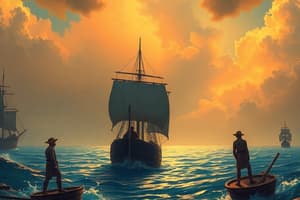Podcast
Questions and Answers
What was the primary source of wealth for the city-state of Malacca?
What was the primary source of wealth for the city-state of Malacca?
- Trade (correct)
- Manufacturing
- Agriculture
- Mining
What significant geographic feature did the city-state of Malacca control?
What significant geographic feature did the city-state of Malacca control?
- The Strait of Malacca (correct)
- The Panama Canal
- The Suez Canal
- The Bering Strait
Which technological innovation enabled sailors to determine their position relative to the equator?
Which technological innovation enabled sailors to determine their position relative to the equator?
- The astrolabe (correct)
- The caravel
- The compass
- The rudder
What was the primary motivation for the Portuguese to conquer the city of Malacca?
What was the primary motivation for the Portuguese to conquer the city of Malacca?
What was a significant consequence of the Portuguese conquest of Malacca?
What was a significant consequence of the Portuguese conquest of Malacca?
Which of the following statements accurately describes the differences in the fates of enslaved people taken in the Indian Ocean trade compared to those taken across the Atlantic?
Which of the following statements accurately describes the differences in the fates of enslaved people taken in the Indian Ocean trade compared to those taken across the Atlantic?
What was the primary reason for the different fates of enslaved people in the Indian Ocean and Atlantic trades?
What was the primary reason for the different fates of enslaved people in the Indian Ocean and Atlantic trades?
Which of the following was NOT a common type of work for enslaved people in the Indian Ocean trade?
Which of the following was NOT a common type of work for enslaved people in the Indian Ocean trade?
Which of the following statements accurately describes the use of lateen sails by Arab sailors?
Which of the following statements accurately describes the use of lateen sails by Arab sailors?
Which of the following was a key factor in the development of sailing technology in the postclassical era?
Which of the following was a key factor in the development of sailing technology in the postclassical era?
Which of the following statements best describes the role of monsoon winds in trade in the Indian Ocean?
Which of the following statements best describes the role of monsoon winds in trade in the Indian Ocean?
What is the main idea of the last paragraph of the passage?
What is the main idea of the last paragraph of the passage?
Flashcards
Astrolabe
Astrolabe
An instrument improved by Muslim navigators to determine latitude.
Malacca
Malacca
A wealthy Muslim city-state known for trade and naval power.
Sultan of Malacca
Sultan of Malacca
The powerful leader who expanded the state in the 1400s.
Portuguese invasion of Malacca
Portuguese invasion of Malacca
Signup and view all the flashcards
Effect of the Portuguese conquest
Effect of the Portuguese conquest
Signup and view all the flashcards
Indian Ocean Slave Trade
Indian Ocean Slave Trade
Signup and view all the flashcards
Peak of Trade
Peak of Trade
Signup and view all the flashcards
Enslaved Roles
Enslaved Roles
Signup and view all the flashcards
Rights of Enslaved People
Rights of Enslaved People
Signup and view all the flashcards
Monsoon Winds
Monsoon Winds
Signup and view all the flashcards
Sailing Technology
Sailing Technology
Signup and view all the flashcards
Dhow
Dhow
Signup and view all the flashcards
Cultural Exchange
Cultural Exchange
Signup and view all the flashcards
Study Notes
Indian Ocean Slave Trade
- Enslaved people from eastern Africa were sold to buyers in northern Africa, the Middle East, and India, transported by land or sea routes in the Indian Ocean.
- The trade peaked in the 18th and 19th centuries.
- Enslaved people in the Indian Ocean trade often worked in seaports (shipping, household service), sometimes as sailors or soldiers, and had more opportunities in urban environments and interaction with free laborers than those taken to the Americas.
- Enslaved people in Islamic communities sometimes had rights, like marriage.
- African words, musical styles, and customs spread to Oman, India, and other regions due to this trade.
Environmental Knowledge in Indian Ocean Trade
- Knowledge of monsoon winds (northeast in winter, southwest in spring/summer) was crucial for successful voyages.
- Merchants timed voyages carefully, often staying in port for extended periods.
Advances in Maritime Technology
- Arab sailors used triangular lateen sails, which were efficient for catching winds from various directions.
- Chinese sailors invented the stern rudder, improving ship stability and maneuverability.
- Dhows (small wooden vessels) were dominant in the Postclassical Era.
- Sailing technology spread rapidly across Indian Ocean regions.
- The astrolabe, improved by Muslim navigators, allowed for determining latitude.
Growth of States and Trade Networks
-
Trading networks in the Indian Ocean led to state growth, particularly the institution of trade revenue.
-
Malacca (Melaka) became a wealthy city-state through its navy and fees on ships using the Strait of Malacca between India and China.
-
Malacca expanded its territory in the 1400s.
-
Malacca's wealth was based on trade, not agriculture, mining, or manufacturing.
-
The Portuguese invaded Malacca in 1511, seeking to control trade flow, becoming wealthy in the process but facing conflicts and trade diversification.
Studying That Suits You
Use AI to generate personalized quizzes and flashcards to suit your learning preferences.




